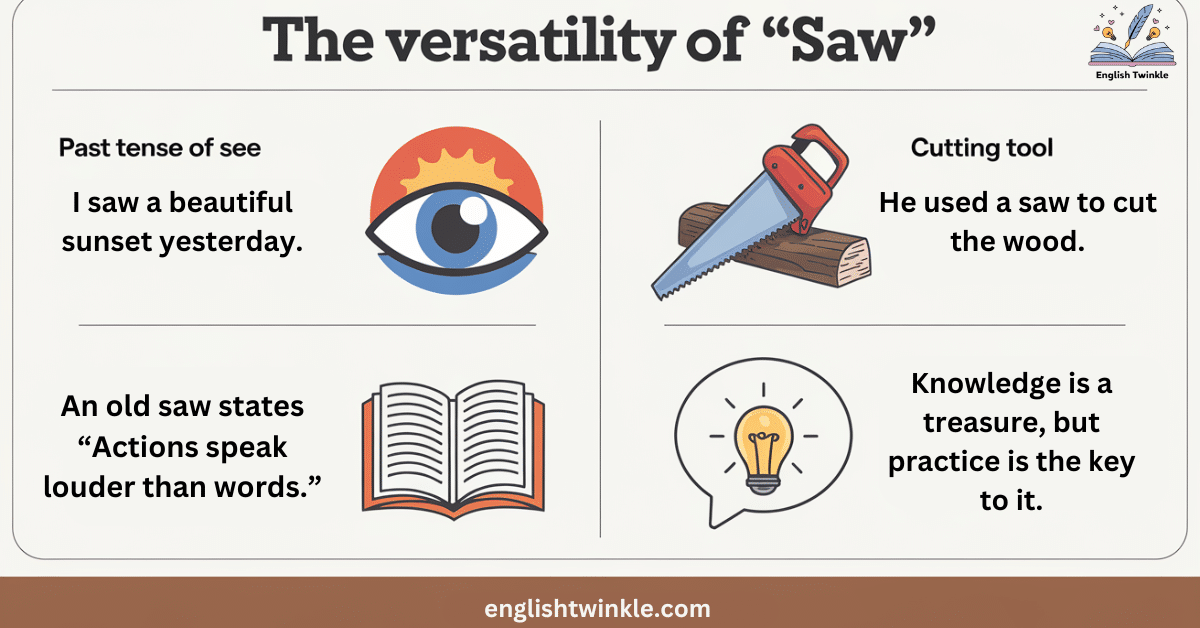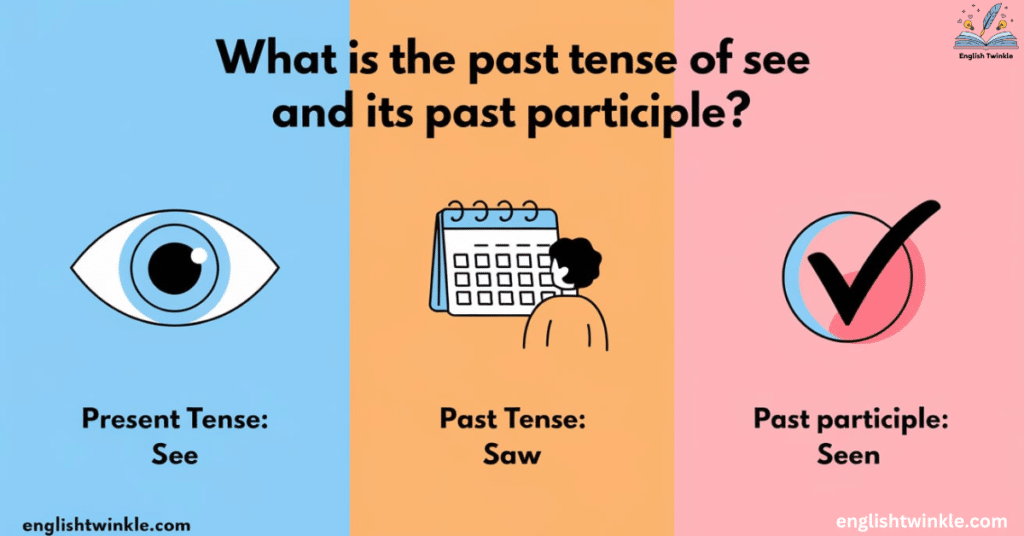Have you ever saw a rainbow and struggled to describe it later? Or maybe you’ve seen a playful cat but weren’t sure how to tell the story? If you’ve ever felt tongue-tied when using the past forms of “see,” you’re not alone. This tricky verb trips up even native English speakers. Let’s dive into the world of “see” and unravel its past tense and past participle mysteries, focusing particularly on the past tense of see.
The Curious Case of “See”
In the present tense, “see” is straightforward. You see a bird, I see a tree, we all see the world around us. But when we step into the past, things get interesting.
“See” is an irregular verb, which means it doesn’t follow the standard “-ed” rule for past tense. Instead, it transforms in unique ways that have roots in Old English. Let’s break it down:
- Present tense: see
- Past tense: saw
- Past participle: seen
Why “See” Breaks the Rules
English is a language of exceptions, and “see” is a prime example. Its irregularity comes from its Germanic origins. Many commonly used verbs in English retained their irregular forms as the language evolved. This quirk adds flavour to our language but can be a headache for learners.
The verb “see” has a long history, dating back to Old English “seon,” which became “see” in Middle English. The past tense “saw” comes from Old English “seah,” while “seen” evolved from “gesegen.” This linguistic journey explains why “see” doesn’t conform to regular verb patterns.
Past Tense of “See”: Saw
When you’re talking about something that happened in the past, you use “saw.” For example:
- “I saw a bird flying over the lake yesterday.”
- “She saw a big tree while hiking in the forest.”
Examples in Context
| Present Tense | Past Tense |
|---|---|
| I see a cat. | I saw a cat. |
| They see the movie. | They saw the movie. |
| We see a rainbow. | We saw a rainbow. |
“I saw the future in your eyes, and it was beautiful.” – Unknown
Remember, “saw” is used for a specific point in the past. It’s a completed action that doesn’t continue into the present.
The Versatility of “Saw”

“Saw” isn’t just for visual experiences. It can be used in various contexts:
- Visual perception: “I saw a beautiful sunset.”
- Understanding: “I saw what you meant after you explained it.”
- Experience: “The town saw many changes over the years.”
- Meeting or dating: “I saw John at the coffee shop yesterday.”
Past Participle of “See”: Seen
The past participle “seen” is used in perfect tenses and passive voice constructions. It’s always paired with a helping verb like “have,” “had,” or “was.”
Examples:
- “I have seen that movie three times.”
- “The cat had seen a playful cat in the mirror.”
Constructing Perfect Tenses
| Tense | Structure | Example |
|---|---|---|
| Present Perfect | have/has + seen | I have seen a rainbow. |
| Past Perfect | had + seen | They had seen the movie before. |
| Future Perfect | will have + seen | By next week, I will have seen all the episodes. |
The Importance of “Seen” in Passive Voice
“Seen” plays a crucial role in passive voice constructions. For example:
- Active: “The police saw the suspect.”
- Passive: “The suspect was seen by the police.”
This usage is common in formal writing, news reports, and academic texts.
Tricky Situations and Common Pitfalls

“Saw” vs. “Seen”: When to Use Which
One of the most common errors is using “seen” without a helping verb. Remember:
- Correct: I saw a rainbow yesterday.
- Incorrect: I seen a rainbow yesterday.
- Correct: I have seen that movie before.
- Incorrect: I have saw that movie before.
Regional Variations and Colloquialisms
In some dialects, you might hear phrases like “I seen it” instead of “I saw it.” While these forms are used in casual speech in certain regions, they’re not considered standard English and should be avoided in formal writing or speech.
The “Seened” Mistake
Some learners might be tempted to create a past tense by adding “-ed” to “seen,” resulting in the non-existent word “seened.” Always remember that “saw” is the correct past tense form.
Mastering “See” in All Its Forms
Here’s a quick reference chart to help you master “see” in various tenses:
| Tense | Form |
|---|---|
| Present | see |
| Past | saw |
| Present Perfect | have/has seen |
| Past Perfect | had seen |
| Future | will see |
| Future Perfect | will have seen |
The Impact of Correct Usage
Using “see” correctly can significantly impact how others perceive your language skills. In professional and academic settings, proper grammar can be the difference between making a great impression and falling short.
Memory Tricks
To remember the correct forms, try this mnemonic:
“I see with my eyes, I saw with my brain, I have seen it all before, And I’ll see it again!”
Case Study: The Job Interview
Sarah, a recent graduate, was interviewing for her dream job. When asked about her experience, she confidently stated, “I seen many challenges in my internship.” The interviewer’s slight frown was all it took for Sarah to realize her mistake. She quickly corrected herself: “I mean, I saw many challenges.” While she got the job, the initial slip made her appear less polished than she truly was.
The Ripple Effect of Grammar
Correct grammar usage extends beyond just sounding good. It affects:
- Credibility: People are more likely to trust and respect those who communicate clearly.
- Professionalism: In business settings, proper grammar is often equated with attention to detail.
- Academic success: In educational contexts, grammar can impact grades and overall performance.
- Social interactions: Good grammar can enhance personal relationships and social standing.
Beyond Basic Usage
“See” isn’t just about visual perception. It’s used in many idiomatic expressions and phrasal verbs:
- “I see what you mean.” (understand)
- “Let’s see how it goes.” (wait and observe)
- “She couldn’t see eye to eye with her boss.” (agree)
- “The project is seeing some delays.” (experiencing)
- “Can you see to it that this gets done?” (ensure)
Synonyms for More Varied Writing
To avoid overusing “see,” consider these alternatives:
- Observe
- Witness
- Spot
- Notice
- Perceive
- Glimpse
- Discern
- Detect
- Behold
- Regard
Using these synonyms can add depth and variety to your writing, making it more engaging for readers.
Practice Makes Perfect

To truly master the use of “see” in all its forms, regular practice is key. Here are some exercises to help:
- Fill in the blanks:
- Yesterday, I _ (see) a beautiful sunset.
- Have you ever _ (see) the Northern Lights?
- By next year, I will have _ (see) all the wonders of the world.
- Correct the errors:
- I seen a movie last night.
- She has saw the Eiffel Tower.
- They hadn’t saw the report before the meeting.
- Transform sentences:
- Change active to passive: “The dog saw a cat.”
- Change simple past to present perfect: “I saw that play.”
- Change present to future perfect: “I see progress in your work.”
The Evolution of Language
It’s worth noting that language is constantly evolving. While the rules we’ve discussed are considered standard English today, language usage can change over time. What’s considered incorrect now might become acceptable in the future. However, in formal and professional contexts, it’s always best to adhere to current standard grammar rules.
Conclusion
Mastering the past tense and past participle of “see” might seem challenging at first, but with practice, it becomes second nature. Remember:
- Use “saw” for simple past actions.
- Use “seen” with helping verbs in perfect tenses.
- Avoid common mistakes like “I seen” without a helping verb.
By understanding these rules, you’ll communicate more effectively and confidently in English. Whether you’ve saw a big tree or seen a playful cat, you’ll now know exactly how to describe your experiences.
Keep practicing, and soon you’ll see (pun intended!) a significant improvement in your English grammar skills. After all, language learning is a journey, and every step counts. So go out there, experience the world, and describe what you’ve seen with perfect grammar!
Remember, language is a tool for connection and expression. By honing your skills with tricky verbs like “see,” you’re not just improving your grammar—you’re enhancing your ability to share your unique perspective with the world. Whether you’re recounting a breathtaking view you saw on your travels or describing a touching moment you’ve seen in a film, your improved command of English will help you paint vivid pictures with your words.
So, the next time you see a rainbow arching across the sky or witness a playful cat chasing its tail, you’ll have the linguistic tools to capture those moments perfectly. Keep seeing, keep learning, and keep sharing your experiences with the world!

